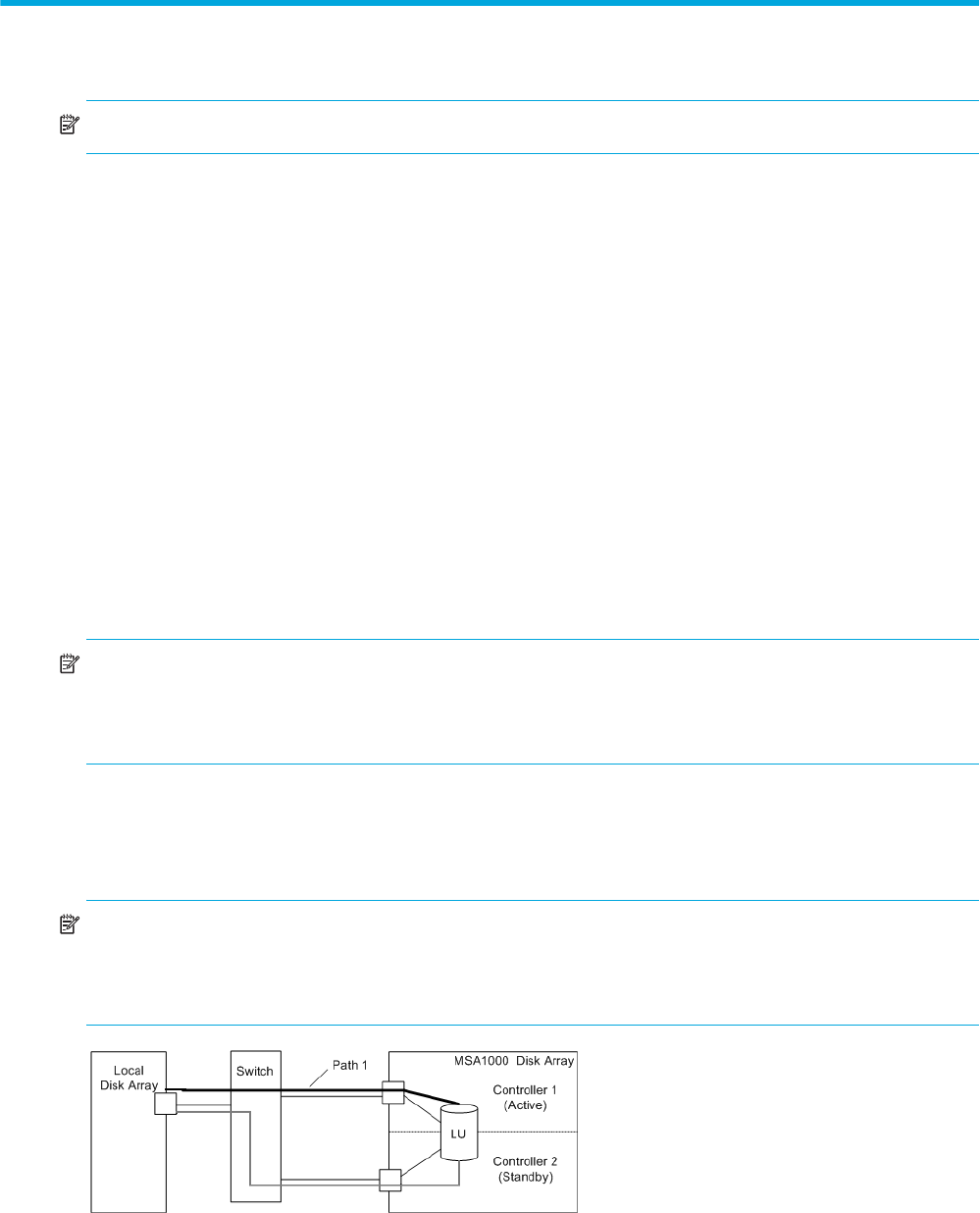HP StorageWorks External Storage XP user guide (T1706-96006, June 2006)
Table Of Contents
- HP StorageWorks External Storage XP user guide
- Contents
- About this guide
- 1 Overview of connecting external arrays
- 2 Preparing for External Storage XP operations
- System requirements
- External Storage XP requirements
- Installing External Storage XP
- Preparing for External Storage XP settings
- Powering arrays on or off
- Using mapped external LUs from the host connected to the local array
- Uninstalling External Storage XP
- Limitations on External Storage XP operations
- Figure 11 Example of external LU with 2 TB or less
- Figure 12 External LU capacity is larger than the specified emulation type’s basic capacity (OPEN-3 example)
- Figure 13 External LU capacity is smaller than the specified emulation type’s basic capacity
- Table 4 When external LU’s emulation type is OPEN
- Table 5 When external LU’s emulation type is for mainframes
- Combining External Storage XP with other HP StorageWorks products
- 3 Managing cache with external storage
- Guidelines for using cache with external storage
- Determining, setting, or changing the external LU cache mode
- Partitioning cache for external storage
- Determining the number and size of needed partitions
- Creating Cache partitions
- Changing storage system modes
- 4 External Storage XP panes
- 5 Configuring external LUs
- Overview of configuring external LUs
- Setting an external array’s port
- Setting a local array’s port attributes
- Mapping external LUs (Add LU)
- Setting alternate paths for external LUs
- Adding alternate paths by selecting multiple external LUs (Add Paths)
- Deleting alternate paths by selecting multiple external LUs (Delete Paths)
- Checking an external LU’s status (LDEV Information)
- Disconnecting external arrays or LUs
- Checking the connection status and resuming external LU operations (Check Paths & Restore Vol.)
- Restoring external LUs (LDEV Restore)
- Stopping the use of paths to an external LU by specifying an external array’s WWN (Disconnect Paths)
- Restoring paths to an external LU by specifying an external array’s WWN (Check Paths)
- Changing an external array’s port setting
- Stopping the use of paths to an external LU by specifying a local array’s port (Disconnect Paths)
- Restoring paths to an external LU by specifying a local array’s port (Check Paths)
- Deleting external LU mappings (Delete LU)
- 6 Troubleshooting NAS Blade systems that include external arrays
- 7 Remote command devices
- 8 Troubleshooting External Storage XP
- A Notes on connecting external arrays
- Connecting Thunder 9500V subsystems
- System parameters for connecting Thunder 9500V subsystems
- Relationship between serial numbers in the Device list on the LU Operation pane and Thunder 9500V subsystem models
- Relationship between the WWN of the port on the Thunder 9500V subsystem and the controller
- Path status and examples of recovery procedures (Thunder 9500V subsystems)
- Connecting TagmaStore AMS and TagmaStore WMS subsystems
- System parameters for connecting TagmaStore AMS and TagmaStore WMS subsystems
- Relationship between serial numbers in the Device list on the LU Operation pane and TagmaStore AMS and TagmaStore WMS subsystem models
- Relationship between the WWN of the port on the TagmaStore AMS or TagmaStore WMS subsystem and the controller
- Path status and examples of recovery procedures (TagmaStore AMS and TagmaStore WMS subsystems)
- Connecting XP12000/XP10000 Disk Arrays
- Connecting XP1024/XP128 Disk Arrays
- Connecting XP512/XP48 Disk Arrays
- Connecting HP 200 Storage Virtualization System as external storage
- Connecting EVA arrays
- Connecting Thunder 9500V subsystems
- B Required volume capacity for emulation types
- C Adjusting volume capacity for copy pair setting
- D Using an XP12000/XP10000/SVS200 with an EVA3000/5000 external storage
- E Configuring MSA1000/1500 as external arrays
- Index

External Storage XP user guide 155
E Configuring MSA1000/1500 as external arrays
NOTE: Externally connected MSAs must not contain Continuous Access XP P-VOLs or S-VOLs.
Configuring external array LUs, host mode, and ports
This appendix describes how to configure the MSA external array. For other arrays, see the
documentation for that external array.
You do not need to configure the SAN topology parameters on the MSA array. The MSA automatically
detects whether it is connected to the local array via a switch or point-to-point connection, and adjusts its
parameters accordingly.
If no LUNs are available on the MSA, you must create them.
1. Set the channel transfer speed according to the configuration.
Generally, select Auto Negotiation.
2. Use Selective Storage Presentation to configure the MSA LUs involved with External Storage XP.
Connecting MSA1000/1500
If you connect an HP StorageWorks Modular Smart Array (MSA) with two controllers (highly
recommended) as an external array, set the port’s host mode to Tru64 and use Selective Storage
Presentation.
NOTE: If only a single MSA controller will be known to the XP12000/XP10000/SVS200, using
Selective Storage Presentation in the MSA ACU is optional and the host mode may be set to Windows.
For the purposes of this document, it is assumed that two MSA controllers are in use, which greatly
improves the array’s availability and allows primary copies of important data to be stored on the MSA.
See the following documents for information about configuring MSA:
• HP StorageWorks Modular Smart Array quickspecs
• HP Array Configuration Utility User Guide
NOTE: References to MSA generally refer to both the MSA1000 and the MSA1500 (both with an
Active/Passive controller). Although the standby MSA controller may connect to the same
XP12000/XP10000/SVS200 port as the active MSA controller (shown in Figure 83), HP recommends
that it connect to an XP port on a different XP cluster.
Figure 83 Example: Connecting an MSA array










